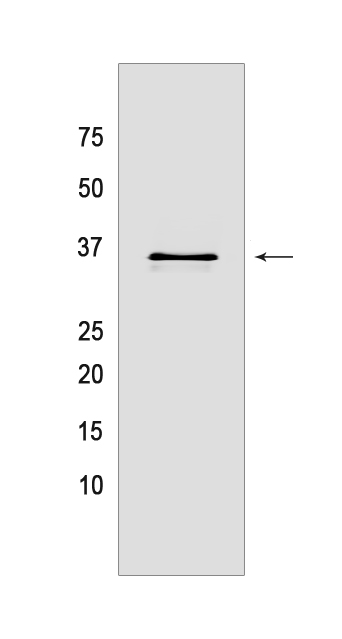ZFP36 Mouse mAb[OFK0]Cat NO.: A95246
Western blot(SDS PAGE) analysis of extracts from HepG2 cells.Using ZFP36 Mouse mAb IgG [OFK0] at dilution of 1:1000 incubated at 4℃ over night.
Product information
Protein names :ZFP36,G0S24,NUP475,RNF162A,TIS11A,TTP,TTP_HUMAN,mRNA decay activator protein ZFP36
UniProtID :P26651
MASS(da) :34,003
MW(kDa) :34kDa
Form :Liquid
Purification :Protein A purification
Host :Mouse
Isotype :IgG
sensitivity :Endogenous
Reactivity :Human,Mouse
- ApplicationDilution
- 免疫印迹(WB)1:1000-2000
- The optimal dilutions should be determined by the end user
Specificity :Antibody is produced by immunizing animals with a synthetic peptide of human ZFP36.
Storage :Antibody store in 10 mM PBS, 0.5mg/ml BSA, 50% glycerol. Shipped at 4°C. Store at-20°C or -80°C. Products are valid for one natural year of receipt.Avoid repeated freeze / thaw cycles.
WB Positive detected :HepG2 cells
Function : Zinc-finger RNA-binding protein that destabilizes several cytoplasmic AU-rich element (ARE)-containing mRNA transcripts by promoting their poly(A) tail removal or deadenylation, and hence provide a mechanism for attenuating protein synthesis (PubMed:9703499, PubMed:10330172, PubMed:10751406, PubMed:11279239, PubMed:12115244, PubMed:12748283, PubMed:15187101, PubMed:15634918, PubMed:17030620, PubMed:16702957, PubMed:20702587, PubMed:20221403, PubMed:21775632, PubMed:27193233, PubMed:23644599, PubMed:25815583, PubMed:31439631). Acts as an 3'-untranslated region (UTR) ARE mRNA-binding adapter protein to communicate signaling events to the mRNA decay machinery (PubMed:15687258, PubMed:23644599). Recruits deadenylase CNOT7 (and probably the CCR4-NOT complex) via association with CNOT1, and hence promotes ARE-mediated mRNA deadenylation (PubMed:23644599). Functions also by recruiting components of the cytoplasmic RNA decay machinery to the bound ARE-containing mRNAs (PubMed:11719186, PubMed:12748283, PubMed:15687258, PubMed:16364915). Self regulates by destabilizing its own mRNA (PubMed:15187101). Binds to 3'-UTR ARE of numerous mRNAs and of its own mRNA (PubMed:10330172, PubMed:10751406, PubMed:12115244, PubMed:15187101, PubMed:15634918, PubMed:17030620, PubMed:16702957, PubMed:19188452, PubMed:20702587, PubMed:20221403, PubMed:21775632, PubMed:25815583). Plays a role in anti-inflammatory responses,suppresses tumor necrosis factor (TNF)-alpha production by stimulating ARE-mediated TNF-alpha mRNA decay and several other inflammatory ARE-containing mRNAs in interferon (IFN)- and/or lipopolysaccharide (LPS)-induced macrophages (By similarity). Plays also a role in the regulation of dendritic cell maturation at the post-transcriptional level, and hence operates as part of a negative feedback loop to limit the inflammatory response (PubMed:18367721). Promotes ARE-mediated mRNA decay of hypoxia-inducible factor HIF1A mRNA during the response of endothelial cells to hypoxia (PubMed:21775632). Positively regulates early adipogenesis of preadipocytes by promoting ARE-mediated mRNA decay of immediate early genes (IEGs) (By similarity). Negatively regulates hematopoietic/erythroid cell differentiation by promoting ARE-mediated mRNA decay of the transcription factor STAT5B mRNA (PubMed:20702587). Plays a role in maintaining skeletal muscle satellite cell quiescence by promoting ARE-mediated mRNA decay of the myogenic determination factor MYOD1 mRNA (By similarity). Associates also with and regulates the expression of non-ARE-containing target mRNAs at the post-transcriptional level, such as MHC class I mRNAs (PubMed:18367721). Participates in association with argonaute RISC catalytic components in the ARE-mediated mRNA decay mechanism,assists microRNA (miRNA) targeting ARE-containing mRNAs (PubMed:15766526). May also play a role in the regulation of cytoplasmic mRNA decapping,enhances decapping of ARE-containing RNAs, in vitro (PubMed:16364915). Involved in the delivery of target ARE-mRNAs to processing bodies (PBs) (PubMed:17369404). In addition to its cytosolic mRNA-decay function, affects nuclear pre-mRNA processing (By similarity). Negatively regulates nuclear poly(A)-binding protein PABPN1-stimulated polyadenylation activity on ARE-containing pre-mRNA during LPS-stimulated macrophages (By similarity). Also involved in the regulation of stress granule (SG) and P-body (PB) formation and fusion (By similarity). Plays a role in the regulation of keratinocyte proliferation, differentiation and apoptosis (PubMed:27182009). Plays a role as a tumor suppressor by inhibiting cell proliferation in breast cancer cells (PubMed:26926077).., (Microbial infection) Negatively regulates HTLV-1 TAX-dependent transactivation of viral long terminal repeat (LTR) promoter..
Tissue specificity :Expressed in both basal and suprabasal epidermal layers (PubMed:27182009). Expressed in epidermal keratinocytes (PubMed:27182009). Expressed strongly in mature dendritic cells (PubMed:18367721). Expressed in immature dendritic cells (at protein level) (PubMed:18367721)..
Subcellular locationi :Nucleus. Cytoplasm. Cytoplasmic granule. Cytoplasm, P-body.
IMPORTANT: For western blots, incubate membrane with diluted primary antibody in 1% w/v BSA, 1X TBST at 4°C overnight.


